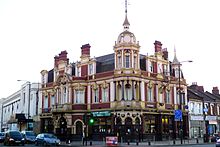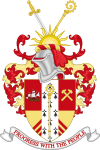Manor Park, London
This article needs additional citations for verification. (May 2008) |
| Manor Park | |
|---|---|
 Manor Park Library | |
Location within Greater London | |
| Population | 15,318 (2011 Census Ward)[1] |
| OS grid reference | TQ425855 |
| London borough | |
| Ceremonial county | Greater London |
| Region | |
| Country | England |
| Sovereign state | United Kingdom |
| Post town | LONDON |
| Postcode district | E12 |
| Dialling code | 020 |
| Police | Metropolitan |
| Fire | London |
| Ambulance | London |
| UK Parliament | |
| London Assembly | |
Manor Park is a residential area of the London Borough of Newham in east London, England. The area is bordered by Ilford to the east, Forest Gate to the west, Wanstead to the north, and East Ham to the south.
It was originally a part of the hundred of Becontree, and part of the historic county of Essex. Since 1965, Manor Park has been part of the London Borough of Newham, a local government district of Greater London. The area forms the majority of the London E12 postcode district.
History
[edit]
The area known as Manor Park is not formally defined, but is more or less coterminous with the Ancient Parish of Little Ilford. Romford Road, the Roman Road from Aldgate to Colchester, is the main east–west route through the area. This well-established coaching route linking the city with the towns of Essex was maintained by the Middlesex and Essex turnpike trust from 1721. The principal local road ran south from the Romford Road and the northern end was known in the 18th century and later as White Post Lane (now known as High Street North), from a post standing at its junction with Romford Road. The 'White Post' appears to have stood on the site of the Earl of Essex public house. A hamlet known as North End was located amongst fields that dominated this area.
By the middle of the next century, the rural scene had begun to change as the railways started to spread outwards from London, followed by the development of estates of suburban houses. There were three railway stations close by: Forest Gate which first opened in 1840, Manor Park which opened in 1873 and Woodgrange Park which opened in 1894. Tramways operated along the Romford Road.
The beginnings of development along the south of Romford Road took place in 1867, especially close to the junction of High Street North and the site of the future Earl of Essex public house. Behind terraces of workers' houses was an animal charcoal works, an unpleasant and noxious manufacturing process involving the carcasses of dead horses. Animal charcoal was used as a filter, particularly in the sugar industry. As the area became more built up such trades disappeared and the charcoal works had gone by the 1890s, replaced by a Board School (Salisbury junior mixed and infants) which opened in 1893.
Apart from four pairs of small semi-detached agricultural workers' houses, known as Ebor Cottages, the area to the north of Romford Road was ripe for development; the owners, the Gurney family, sold 110 acres of market garden land to Thomas Corbett in 1877. The Corbett family built the Woodgrange and Durham Road estates between 1877 and 1892. The Forest Gate Weekly recorded the attractiveness of the estate, it having "the three great essentials to the average city man of easy access, reasonable rentals and a first class local market."
By the 1890s, Forest Gate was an upmarket suburb for the aspiring middle class commuter, who could use the Eastern Counties Railway from Manor Park to travel to the city. The area around the junction of Manor Park and White Post Lane (later High Street North) became an important shopping and provisioning area for nearby residents who populated the new streets in the area. In 1898, 1,129 houses accommodated about 6,000 inhabitants were built in Little Ilford on the site of the old Manor Farm.
Geography
[edit]Manor Park was part of the County Borough of East Ham, Essex until 1965, when the Greater London county was formed. The area postcode is E12 and it is part of the East London post town.
Durham Road Conservation Zone
[edit]The Durham Road Conservation Zone is a small late-Victorian development,[2] built close to Manor Park station. It was designated a Conservation Area in 1984 to retain its original charm and character. Additional planning controls were introduced in 1998 to protect and enhance its special character. The area, popularly referred to as Manor Park Village, was originally developed in the 1880s on farmland that formed part of the Gurney estate. It was built by one builder to an overall plan, with a limited range of house styles giving the area a distinctive character and unity. The developers, the Corbett family, built several suburban estates including the adjacent Woodgrange Estate in Forest Gate.
Transport
[edit]Romford Road, a stretch of the A118, runs for much of its length in both Newham and Redbridge, providing the main road route through Manor Park and linking the eastern districts with the city of London.
Manor Park railway station is a stop on the main public transport link, the Elizabeth line. Trains between Shenfield, Liverpool Street, Paddington and Heathrow Terminal 5 run every ten minutes.[3] Nearby Woodgrange Park station is on the Barking to Gospel Oak line, popularly referred to as the Goblin, which is part of the London Overground network. Both stations are in Zone 3.
Education
[edit]Manor Park is home to many primary schools, including Salisbury primary school,[4] which opened in 1893; it is accessible by the main Romford Road or High Street North.
Sport
[edit]Manor Park also has an amateur football team called A.C. Manor Park, who play in the AFL.[clarification needed]
In Popular Culture
[edit]Little Ilford Park was made famous in a song called Itchycoo Park by the Small Faces, whose lead singer Steve Marriott lived in the area.[5]
Notable people
[edit]- Michael Blaney, World War II bomb disposal officer from Newry; died when a bomb he was trying to defuse exploded in Manor Park; Blaney Cresecent in East Ham is named after him; awarded the George Cross[6]
- Clive Burr, drummer with Iron Maiden, grew up in Manor Park
- Jack Cornwell, posthumous teenage recipient of the Victoria Cross in 1916, grew up in Manor Park and is buried at the Manor Park Cemetery
- Greer Garson, Oscar-winning film actress, born in Manor Park in 1904
- Bobby George, darts player and pundit. Born in Manor Park, 1945.
- Jimmy Greaves, footballer, born Manor Park in 1940.
- Stanley Holloway, actor, born at 25 Albany Road (at which there is an English Heritage blue plaque erected in 2009)
- Steve Marriott, lead singer and guitarist of Small Faces and Humble Pie, was born in Manor Park
- Kele Okereke, lead singer of Bloc Party, is from Manor Park
- Matt Taylor, space scientist, who landed the Rosetta spacecraft on a comet. Born in Manor Park, 1973.
References
[edit]- ^ "Newham Ward population 2011". Neighbourhood Statistics. Office for National Statistics. Archived from the original on 21 October 2016. Retrieved 17 October 2016.
- ^ Website regarding the conservation area, including pdfs with more detail https://manorparkvillage.wordpress.com/durham-road-conservation-zone/
- ^ "Elizabeth Line Timetables". Transport for London. 10 December 2023. Retrieved 20 April 2024.
- ^ Salisbury Primary School
- ^ "Itchycoo Park lyrics by Small Faces, 2 meanings, official 2022 song lyrics | LyricsMode.com".
- ^ "Michael Blaney and Raymond Kelly honoured in Newry". BBC News. BBC. 7 December 2013. Retrieved 7 December 2013.



